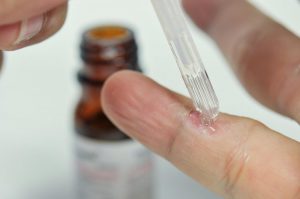There are dozens of types of human papillomavirus (HPV). Some of them do not cause any particular harm. Others cause warts and papillomas on the skin and mucous membranes. And the most dangerous can trigger the development of cancer, especially in women. That is why early and accurate diagnosis of HPV can save lives.
![hpv-1[1]](https://papillomas.org/wp-content/uploads/2019/10/hpv-11-300x225.jpg)
Contents
- What is Papilloma?
- What is Human Papillomavirus (HPV) and How Dangerous Is It?
- When Is HPV Test Prescribed?
- Research Methods to Define Human Papillomavirus Type
- Investigated Biomaterial
- How Often Should You Take HPV Test?
What is Papilloma?
Papilloma definition sound like the following “ It is a benign formation, which is a manifestation of human papillomavirus (HPV).” Papillomas may not manifest themselves for the long period of time if the virus isn’t active. In case, there are favorable conditions for the virus activity, for example, decrease of immunity, papillomas may appear on any part of the body. More than 90% of all people are carriers of viral papillomatosis.
How is it possible to define papilloma? By some signs, you can immediately distinguish papilloma from such growths as moles and warts. A characteristic feature of papilloma is a form of «fungus»: a wider formation of a rounded shape located on the stem. Keep in mind that flat papillomas may also form. So, it is better to consult the doctor concerning the definition of papilloma type.
Back
What is Human Papillomavirus (HPV) and How Dangerous Is It?
Human papillomavirus is spread very widely, 80% of the entire population of the planet is infected with it. This virus is transmitted from person to person — through sexual intercourse, household or during childbirth from mother to child. Human papilloma virus definition is as follows: Once in the body, this infection is inserted into the cell’s DNA, forcing it to divide not in the manner provided by the human body “program”, but in the way the virus needs. The result is flat and common papillomas. When infected with certain types of virus, they can degenerate into cancerous tumors.

According to the papilloma virus definition, the most oncogenic viruses are human papillomaviruses 16 and 18 types. Type 16 virus is found in half of cases of cervical cancer, type 18 virus in 10% of cases. The virus may be present in the body, but it does not manifest itself. Our immune system is able to restrain it for a long time. But enough of any failure in the body — a serious infectious disease, prolonged stress, the effects of alcohol, nicotine or drugs — that the virus is activated and broke through the protective barrier.
When Is HPV Test Prescribed?
If the doctor finds signs of virus activity on your body, he/she will recommend you to have an examination for the papillomas definition. It is not enough to know that the virus as such is present in the body — it is much more important to find out its type, since, as has already been said, HPV can be both relatively harmless or dangerous.
An analysis of the human papillomavirus must be done even if you are planning pregnancy, as well as in identifying the causes of infertility, miscarriages and gestational pathologies. Moreover, both partners must undergo an examination — HPV is transmitted through unprotected sexual intercourse very easily, and if one of the partners is infected, then the second one is also sure.
![1468520510154[1]](https://papillomas.org/wp-content/uploads/2019/10/14685205101541-300x225.gif)
Research Methods to Define Human Papillomavirus Type
There are several methods of laboratory and instrumental diagnosis of human papillomavirus. They pursue several goals: first, to reveal the very fact of the virus, secondly, to find out its variety, and thirdly — to assess the damage caused to them, and also to find out whether the process of degeneration of a harmless condyloma into a malignant tumor has already begun.
- Colposcopic examination, It is assigned to women for the detection of warts located in the cervix area. The study is quite simple — with a special microscope, the doctor examines the mucous membranes of the cervix and vagina. Repeated (8–16-fold) magnification allows you to see even very small warts. The result is usually handed out immediately after the examination.
- Cytological examination. The material for this laboratory test is a smear that contains epithelial cells. Cell samples are examined under a microscope. Such a study allows you to notice the modified cells, indicating a viral infection. This method is simple and cheap, but not very accurate — there is a high risk of a false-negative result. The result of the analysis is given in 5–7 days and is indicated in the form with a digital code. 1 — there are no affected cells, 2 — cells detected due to inflammatory processes are detected, 3 — the result is doubtful, additional examination is necessary, 4 or 5 — the presence of affected cells.
- Histological examination is usually prescribed in addition to cytology. This is a laboratory method for the study of biopsy, that is, a small piece of tissue. The specialist examines the drug in a microscope and assesses the state of the affected cells. Histological examination makes it possible to determine the nature of the tumor and to distinguish the condyloma from the tumor. Usually, the result can be obtained in 3 days. As a rule, after histological analysis, PCR analysis is prescribed.
- PCR diagnostics is one of the most reliable diagnostic methods used to detect many bacteria and viruses. With the help of PCR diagnostics, it is possible to detect the DNA of a virus even if the amount of the pathogen in the blood is extremely small and it does not manifest itself. The accuracy of the method is close to 100%, but it is strongly influenced by adherence to the technique of the study.

Therefore, PCR analysis is best done only in those laboratories where they strictly monitor compliance with all standards. The test material most often becomes a smear, but sometimes the amniotic fluid, urine, or blood are examined. The results of the study will be ready in 1-2 days, in some cases they can be obtained even on the day of treatment, because the research itself takes only 4-5 hours. PCR allows you to very accurately determine the amount of virus in the biomaterial. The final digit indicates the number of genomes. PCR allows you to very accurately determine the amount of virus in the biomaterial. The final figure indicates the number of genomic equivalents per 100 thousand cells. If the virus is not detected at all, it will be indicated on the form. If the virus is present, the results will indicate its concentration.
- Lg <3 — the HPV virus exists, but its concentration is extremely low.
- Lg 3-5 — a clinically significant amount of the virus.
- Lg> 5 — high viral load.
If any of these studies give a positive result, your doctor will likely refer you for a reanalysis. With modern methods of laboratory research, the risk of error is low, but non-zero. Most often, a false positive result is the result of contamination of the biomaterial and violation of its sampling technique, the wrong time for the study (for example, you were treated and the virus was destroyed, but traces in the biomaterial can still be detected) or the patient does not follow the rules for preparing for the analysis.
Patients have many questions, an ambiguous situation in which papillomas are, however, tests do not reveal the virus itself. This happens if at some point in the past the virus was active and led to the formation of warts and papillomas, however, the immune system subsequently strengthened and suppressed its activity. But papillomas cannot resolve themselves. In this case, the best solution is to simply remove the papillomas and do not forget to undergo regular examinations.
Investigated Biomaterial
The main biomaterial for analyzing human papillomavirus is epithelial cells obtained by smearing the urethra in men and from the cervical canal in women. Technically, a blood test, vaginal and urethral discharge, amniotic fluid and urine can be examined for PCR analysis, but in practice these types of biomaterial are practically not used. To conduct a histological examination, a bioptat is required, a small sample of tissue from the affected area, which is pinch off with a special device. Biopsy sampling from the cervix is a much more serious matter. 2 days before the biopsy, a woman must not have sex, douche, use any local antibacterial agents and tampons. After a biopsy for at least 2–3 weeks, you should not have sex; during bleeding, only pads are allowed, but not tampons. Substantial physical exercise, overheating, swimming in a pool or an open pond, any blood thinning medications, and any vaginal products such as gels, sprays, suppositories, etc., are prohibited.
How Often Should You Take HPV Test?
It is necessary to take a test for human papillomavirus regularly, starting at the age of 20-25 years. This is especially true for women — not detected in time HPV can lead to problems with conception, infertility, miscarriage, cervical dysplasia and the appearance of malignant tumors. It is necessary to pass the examination every three years. If you are at risk — that is, you smoke or drink large quantities of alcohol, you often change your sexual partners and you are sick of infectious diseases — the examination should be carried out once a year.